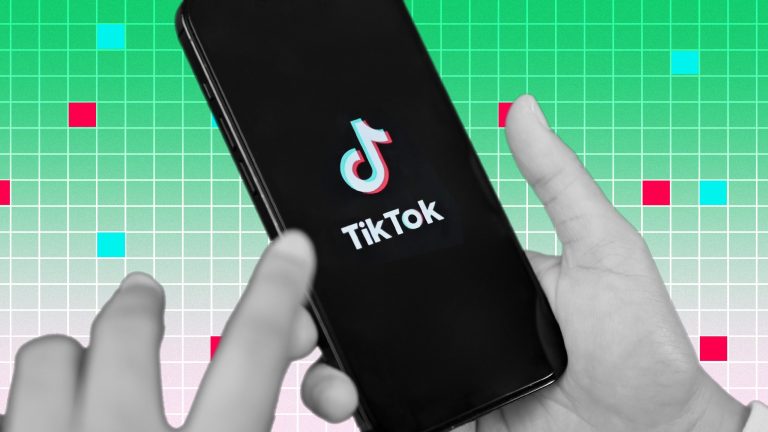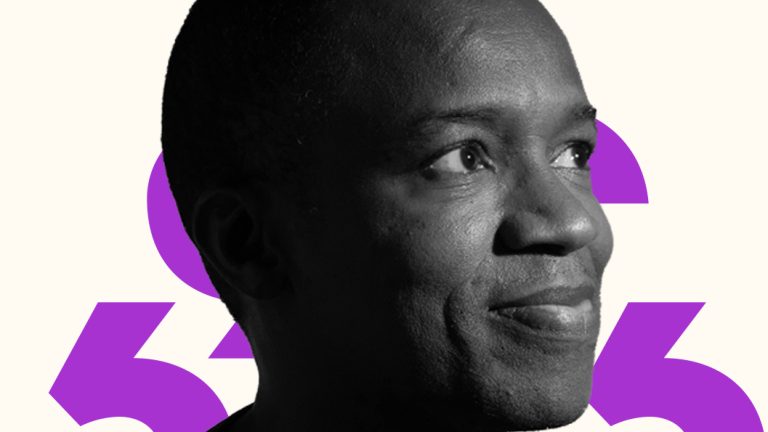Her face colored by red neon lights, Anastasiia Kanshina grooved quietly, her phone on the table in front of her, alongside pages of notes and an unopened box holding a wireless speaker. Eight seconds later, she burst into laughter as she realized that the camera in front of her had already started rolling.
“Ah, I can’t see myself [in the camera monitor],” she said in Chinese, before regaining her composure and switching to Russian. “Hello everyone! Welcome to the channel Blooming Show. My name is Nastya, and today our broadcast is in Russian. Today my broadcast is all about a brand that’s already pretty well-known.”
From a studio in Shenyang, a city in northeastern China, Kanshina, a 29-year-old from the Russian city of Irkutsk, is broadcasting to thousands of viewers in Russia and Ukraine. Today, she is selling wireless speakers and chargers manufactured by Anker. But since she started livestreaming in 2019, she has hawked everything from smartphones to baby toys. Her three hour-long shows each week are a reboot of the TV shopping programs that emerged in the 1980s and have since proliferated worldwide, but with live interactions and mobile payments processed through an app made by AliExpress, the international arm of the Chinese e-commerce giant Alibaba.
“I didn’t expect livestreaming to become my job,” said Kanshina, who arrived in Shenyang in 2013 for a master’s degree in international trade. She stayed in China to work in customer service for Neusoft Cloud Technology, a company that operates multi-language call centers for AliExpress. When Neusoft reached out to its Russian-speaking employees to bootstrap an experiment in livestreaming in 2018, Kanshina was initially reluctant. “But my previous manager said, ‘Her! She wants it! She likes to talk!’” Kanshina told Rest of World. “And I said, ‘OK, I can give it a try.’”
She hosted her first independent show in March 2019 and since then has been regularly broadcasting every week. Her audiences are mostly from Russia, but some viewers tune in from Ukraine, Kazakhstan, Belarus, and other Russian-speaking countries. This past March, she broke a personal record, attracting over 20,000 viewers at once in a live show for Xiaomi, the Chinese phone manufacturer.
In 2019, live shopping shows on mobile screens completely changed the trillion-dollar Chinese e-commerce market, becoming a major marketing channel for everything from small farms to global luxury brands. Leading livestreamers attract millions of viewers nightly. But the domestic market is becoming increasingly saturated. In search of new sources of growth, China’s e-commerce giants and influencer agencies are now trying to export their model overseas, recruiting foreigners like Kanshina to expand into markets in Eastern Europe.
“It’s widely accepted that China has been the proving ground for so many recent innovations in e-commerce,” said Franklin Chu, a private equity investor and retail expert. “So the fact that it’s worked in China … it’s just inevitable that it will be copied in smaller markets.”
“Livestreaming is basically television shopping plus [social networking],” said Chu, who once sat on the board of the Home Shopping Network, a U.S. TV shopping pioneer.
Livestreaming began in earnest in China in 2016. Hundreds of apps were launched, each offering a different genre of content: e-sports, music, quiz shows, and softcore porn.
That year, Alibaba jumped on the trend with Taobao Live, where influencers could sell products through the Taobao e-commerce platform, but it took nearly three years for the trend of mixing livestreaming with selling to break into the mainstream.
The combination of livestreaming’s real-time interactions between viewer and host and the convenience of e-commerce has been wildly successful. As of June 2020, more than 300 million Chinese citizens regularly shopped through livestreams, according to data from the China Internet Network Information Center, a government agency. The Guangzhou-based business consulting company iiMedia Research estimated that the Chinese livestream e-commerce market was worth more than $67 billion in 2019 and that it could have doubled in size in 2020. Taobao Live, now the dominant player in China, brought in $54 billion in sales for Alibaba last year, including nearly $6 billion on Singles Day, a shopping event that falls on November 11 each year.
Taobao Live’s success inspired Alibaba to overhaul the livestreaming feature of its overseas e-commerce platform, AliExpress, in 2019. Since 2013, Russia has been AliExpress’ largest market, according to the company, and now has more than 20 million active buyers and $3.5 billion in annual sales.
To expand overseas, Chinese e-commerce companies need streamers who speak local languages. That inspired Neusoft to expand beyond call centers and make more use of its foreign talent. “We saw the successful applications of livestreams in China … and also the business potential of cross-border e-commerce platforms,” said Zhihao Wang, planning director of Neusoft’s Digital Social Media Marketing Center. “We decided to train foreign influencers to prepare for overseas livestreams.”
The northeast region of China, where Neusoft is based, is geographically close to Russia and has a sizable number of Russian-speaking residents, making it easy for Wang to scout potential influencers just by going to local bars.
In September, the company employed seven full-time foreign livestream influencers, after several others went home during the coronavirus pandemic. Each of them earns between $30,000 and $60,000 (200,000 to 400,000 yuan) a year, according to Wang. Neusoft also works as an agent for 300 influencers based outside of China, targeting Russian-, Spanish-, and French-speaking markets.
Dmytro Romashko is the most popular of Neusoft’s contract influencers. Before he began writing product reviews on AliExpress in 2014, the 29-year-old, who lives in the Ukrainian capital of Kyiv, had no connections to China. He sent professional photos of himself modeling products and proposed writing reviews for the company blog, which later turned into live streaming. He gave up his job as a government lawyer to become a full-time livestreamer, specializing in selling men’s clothing and tech gadgets, and now has more than 250,000 followers on AliExpress.
“I found that a lot of people come to shows to talk about the product and also to have some emotional exchanges from talking live. [It’s] like a party,” said Romashko, who sometimes spends an hour or more just casually chatting with his fans, without actually marketing anything. “So it’s not just a TV shop but also a lifestyle.”
During a three-hour marathon live show in 2019, Romashko’s stream attracted 364,000 viewers — a fraction of the millions that his Chinese counterparts receive regularly. Livestreaming in Eastern Europe may be growing quickly from a low base, but it’s still unclear when, or if, it will really break out to the extent it has in China.
Because it can be difficult to return products to China, and the dominant view is that AliExpress is a platform for low-cost goods, many customers in Russia and Ukraine are unwilling to spend as much as Chinese consumers via livestreaming. In China, users often spend hundreds of dollars; in Russia, it is only around $20, Romashko said. “If the product is expensive, they need to think. They need to come back to me with questions 20 times on my Instagram,” he explained. They usually end up buying a featured item a week or more after watching the show, making it hard to measure the success of one specific livestream.

Influencers in Eastern Europe often stick to lower-price products: no more than $20 for summer clothing, $30 for a jacket, and between $200 and $300 for a mobile phone, said Zhihao Wang of Neusoft.
The pandemic has given e-commerce a boost in Eastern Europe, as more consumers are staying at home. However, it has also had a significant negative economic impact and reduced people’s purchasing power. In Russia, consumption is expected to contract by 4.9% in 2020, according to the World Bank.
On November 11 and 12, Kanshina streamed four shows for AliExpress’ Singles Day promotion, selling smartphones, security cameras, and jackets. The biggest difference she saw this year was that more viewers were actively demanding discounts and giveaways. “While they were waiting for the live show to begin, they would comment, ‘I wish I could get a free phone today!’” said Kanshina, who could reply with only, “I’m sorry. Next time!”
Despite these roadblocks, analysts in Russia expect that it’s only a matter of time before livestreaming becomes mainstream in the country. “In two years, maybe three years, this type of shopping will become [a] must-have for international brands, first of all, and for big Russian brands,” said Fedor Virin, a Moscow-based e-commerce analyst and founding partner of consultancy Data Insight.
Virin expects domestic Russian e-commerce marketplaces like Wildberries and Ozon to soon invest in their own livestreaming services. “The Russian market is a very impulsive shopping market,” he said, adding that e-commerce purchases in Russia are often heavily incentivized by discounts and promotion gimmicks. “That’s why I think we will [be] very addicted to this type of shopping. But it will take time. Not a lot, but it will take time.”



